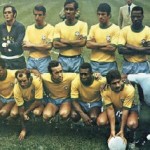Brazilian football, unlike any other cultural interpretation of a particular sport, has the ability to conjure up in one’s mind an essence of mystery, of carnival, of rhythm, of unadulterated joy and freedom.
Futebol is so deeply, so passionately interwoven into the fabric of Brazilian culture that the two entities are inextricably linked, they define each other and share an intrinsic identity, an instantly recognisable global image.
In the 115 years since the beautiful game arrived in Brazil, this most socially vibrant of Latin American countries has peerlessly adapted and excelled at the game, transforming football into an expressionistic art form and an effective tool for social cohesion.
Five World Cup triumphs (1958, 1962, 1970, 1994, 2002) have justifiably given Brazil the status as the greatest nation ever to have taken to a football field and made Brazilian sides throughout modern history, no matter how relatively weak or strong, the benchmark for footballing excellence.
The Evolution of a Philosophy
The philosophy which underpins Brazilian football is, as has been demonstrated since football’s genesis in the country, based around exuberance, enjoyment and individual brilliance within the team collective. As Gilberto Freyre wrote in 1959, “The Brazilians play football as if it were a dance…for [they] tend to reduce everything to dance, work and play alike.”
What Freyre was acknowledging with these words was the pervading Brazilian attitude towards life, that casual, contented, relaxed and playful national stereotype we know so well. These innate characteristics have spilled over into the sporting psyche of the nation, and no more clearly do we see them manifest themselves than in the Brazilian approach to the game of football.
The early Brazilian sides of the 1930s and 40s, despite not being as successful as those which came later in the twentieth century, laid the preliminary foundations for the nature and style which would come to characterise their country’s footballing displays for years to come.
Despite being knocked out at the first hurdle in the World Cup of 1930, Preguinho, by all accounts an elegantly potent centre forward, fascinated spectators with his tenacity, scoring Brazil’s only goal during a 2-1 defeat to Yugoslavia and grabbing a brace in a 4-0 victory over Bolivia. The country’s first World Cup star had been born.
Although they returned home defeated, Brazil had laid down an early marker on the international stage and enthralled the footballing public with their mysteriously, romantically named players and wonderfully fresh and exotic approach to the game. Brazil had arrived in the world’s footballing consciousness and were there to stay.
Despite improvements in their performance over the intervening years, it was not until the 1958 World Cup that Brazil began to truly assert their dominance on the global game. Spearheaded by a youthful Pele and the enigmatic brilliance of the bow-legged Garrincha, Brazil stamped their authority over their opponents, winning the competition with a peerless, swaggering excellence.
Deploying a unique take on the 4-2-4 formation, Brazil’s two superstars combined with Vava and Zagallo to form a lethal attacking foursome. Ably supported from deep by Didi and Zito, Vicente Feola’s side were able to combine defensive rigidity with attacking prowess and verve, a fine tactical blueprint which resulted in one of the finest displays of football ever seen.
At the time, the Italian journalist Thomaz Mazzoni wrote, “English football, well played, is like a symphonic orchestra; well played, Brazilian football is like an extremely hot jazz band.” The Brazilian philosophy and approach to football was becoming admired across the globe, but even brighter achievements lay on the horizon for football’s samba virtuosos.
The 1970 World Cup, staged under the oppressive Mexican sun, saw Brazil reach what has since come to be widely regarded as the highest level of football ever achieved by a single team. Captained by the defensive maestro Carlos Alberto, the Brazil of 1970 set about changing people’s conceptions of the way in which football could be played.

It is the team of 1970 that subsequent Brazil sides have sought to shape themselves in the image of. Carlos Alberto’s team firmly established Brazil as the greatest footballing culture on the planet, a culture the more recent inhabitants of the green and yellow jersey have battled (and at times visibly struggled) to honour ever since. After twenty-four long years without a world title, the class of 1994, a strangely flat and functional unit, re-established Brazil at the pinnacle of the world game, but failed to truly re-assert the footballing philosophy which had been so dazzlingly defined their forebears. In 2002 Brazil triumphed in Japan & Korea, but again the football was more functional, more rigid than it had been in ’58 and ’70.
Pele has recently criticised this fundamental shift in philosophy, focussing his attention on the hard-working but “bureaucratic” midfield duo of Felipe Melo and Gilberto Silva which represents the engine room of Dunga’s Brazil. Both Melo and Silva are tough tackling midfield ball-winners, they are not the easiest on the eye and, as the BBC’s Tim Vickery has pointed out, they barely hold a torch to Clodoaldo and Gerson, the superlative central pairing of 1970.
This very example is emblematic of a series of developments in Brazil’s approach to the game which have occurred over the last three decades. As the pressing game became increasingly popular amongst the top European sides, Brazilian players found that they had less time on the ball and, as a result, discovered that it was almost impossible to continue playing the individualistic, improvisational football which had served them so well during the first forty years of international competition.
In response, Brazilian sides since the mid-1970s have adapted themselves to counteract the evolution in European football philosophy. Muscular, robust midfield stoppers such as Gilberto Silva have become a more common sight in Brazilian midfields, and the counter-attacking game in combination with a more structural approach to defensive organisation has become a regular feature of the Selecao’s football.
Although this reformed approach to the game may have a less romantic shine to it than the football of Garrincha and Pele, it has meant that Brazil have remained highly competitive on the international stage and are able to match traditionally strong European sides such as Italy and Germany in the physical battle. It may not be quite as attractive as the early days, but it is equally as effective and is a living example of the evolution of football over time.
Influences From Outside and Within
Despite the uniqueness and individualistic nature of the Brazilian approach to the game of football, it would be wrong to assume that the country’s footballing culture and development has been impervious to outside influences throughout its history. Indeed, the game in Brazil was initially steeped in the traditions European sporting philosophy and played in the classical European fashion.
Football arrived in Brazil in 1894 courtesy of two relatively unassuming Britons, Charles Miller and Oscar Cox. Such was the very British nature of football’s beginnings in Brazil, the Anglo-Saxon approach to the game was always destined to be woven into the soul of futebol in South America’s largest country. In the early days of the game in Brazil the British “way” of playing was very much in evidence as the dominant approach. Methodical tactical planning, rigidity, even, in combination with direct build-up play characterised the performances of clubs such as Fluminese, their personnel almost exclusively consisting of the sons of Brazil’s European social elite.
However, as the European influence in the country began to fade, there followed a radical democratisation of football, it became the game of the people. Brazil began to shape football in its own social image. Clubs borne out of the working class emerged, Vasco Da Gama, for example, won the national championship with a team full of native black players and members of the white working class.
As a result, the way football was played in Brazil was transformed forever, the English approach was largely replaced with the flamboyant style we all now associate with those who pull on the canary yellow shirt. Despite this dramatic shift, the European defensive and tactical fastidiousness has not entirely vanished from Brazilian game, allowing the Selecao to combine their samba-like speed and innovation with a robust and durable core, a fusion of sporting cultures which has made Brazil the greatest footballing nation on earth.
This osmosis of philosophies, however, is not a unilateral process. As much as European football has come to influence Brazilian football, Brazilian football has equally changed the way in which the European game is played. With such huge numbers of Brazilian and Argentinean players plying their trade in the European leagues, the fact that a South American influence has come to bear in Europe was an inevitable result of the globalisation of football.

In the last twenty years, since the beginnings of the large-scale influx of foreign talent, European football has become more fluid, more expressive and has moved away from the great emphasis on defence and physicality which so dominated its early history. Now we see sides such as Barcelona, Arsenal and the Spanish national team playing an aesthetic, intricate and skillful passing game more reflective of Rio and Sao Paulo than Madrid or London.
Both cultures have come to impact upon each other and infuse one another with the central elements of each philosophy, the result being teams playing robust but, at the same time, intricate football. It is a melting pot of footballing philosophies on which Brazil, perhaps more than any other country, has had a profound effect.
One question often asked is simply how Brazil is able to continue to provide the world with a seemingly limitless wealth of footballing talent. The answer to the question is in part, if not totally, concerned with the country’s sporting culture. Football in Brazil is, to an extent not seen in any other country, a central part of the social and political texture of the nation, an important component of the national psyche. Children are brought up idolising the game, wanting to do little more than to play it and excel at it. In a country where many families struggle to make ends meet, football is a way out of poverty, a way to provide for your family, and it is often this motivation that spurs boys on to achieve great things in the game of football.
Brazilian society with its prevailing conditions, consciously or not, is the perfect production line for footballing talent, as has been proved with the hordes of incredibly gifted players who have made their way to European shores over the last few decades. This hothouse of talent has meant that Brazil has been able to sustain its position at the top of the world game for decades, the national side a global showcase for some of the finest players the game has ever seen.
Contrast with Europe
Ever since football’s establishment as a truly global sport, Brazil (and South America in general) has emerged as the main contender to Europe’s crown as the game’s most fervent stronghold. Where the European continent has long been a bastion of impeccable footballing organisation and high levels of athletic capacity, South America has prided itself on its alternative, almost bohemian attitudes towards the game.
Where European football is today so frequently characterised by stratospheric wages and corporate sponsorship, the South American game, particularly in Brazil, is of a more innocent, playful nature. The professional leagues encourage an exuberance and audacity of spirit, the pursuit of silverware and the financial rewards resulting from it a secondary concern to individual and collective artistic expression. Football in Brazil is business, but it is not yet the lucrative corporate game it has become in Europe, a laden trophy cabinet not being the only measure of success for clubs and players alike.
In fact, it can be said that club football is viewed as being of far less importance than the exploits of the national team by the Brazilian public. Although it could be argued that this attitude is to the detriment of the club game, players want nothing more than to pull on the yellow and green jersey and represent their country.
In Europe “club v country” rows have marred recent years and seen a shift in priority from the international game to the club game, players now seemingly viewing club competitions such as the UEFA Champions League as more important than international fixtures. This approach has seen European clubs establish themselves as the strongest and richest on the planet, but, in the eyes of many, has been to the detriment of national teams across the continent.

It seems that whenever a promising talent emerges in the Brazilian Championship they are snapped up by European clubs with incomparable buying power and taken out of the hands of their native team (who are often sold short with transfer fees), no matter how young, to go and play for one of Europe’s top sides. This situation, the inverse of the problems which occasionally afflict the European game, is hugely beneficial for the Brazilian national team, increasing its strength with players experiencing a higher standard of club football, but has left the clubs of the Brazilian leagues with squads of mediocre players and relatively thin wallets.
There is no doubt that Brazilian football has undergone a dramatic transformation in recent times. From the early exuberance to the recent evolution to a more structured, counter-attacking game, the style may have changed but the ability of the players remains as high or higher than any other country in the world.
Brazil still produces some of the finest footballing talent on the planet, but concerns over the state of the country’s club game continue to grow as players leave home to play abroad on an alarmingly regular basis.
Whether or not Brazilian clubs can sustain this trend we will have to wait and see, but what is certain is that the national team remains one of the strongest around and, after their recent success in the Confederations Cup, go into next summer’s World Cup as one of the favourites, looking to triumph in the tournament for the sixth time in the country’s glorious footballing history.
Also See:
The Greatest Brazilian Players of 50s and 60s
The Greatest Brazilian Players of 70s and 80s
The Greatest Brazilian Players of 90s and 00s
Add Sportslens to your Google News Feed!